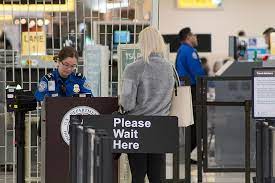The travel season is upon us, and those who will be flying somewhere are probably gearing up for the security hassle they’ll find at the TSA checkpoint.
There’s getting your ID out, and (maybe) your boarding pass – old-school paper or on your phone. (Remind me again where I need to show it.) Then there’s juggling your identification with your carry-on luggage. And, if you’re traveling with your family, hanging on to your kids.
Then there’s your stuff.
Laptop out? Laptop open? Tablet? Kindle? Phone?
Did you remember to put all your liquids in a 1 quart baggie? Are all those liquids smaller than 3.4 ounces? Is toothpaste a liquid? Is peanut butter?
It goes without saying that we all want to be safe when we fly, but at times contending with the protocols can be an irritant when all you want to do is make it to your gate on time.
Fortunately, the TSA has been introducing technology that will expedite the process. The new tech will help on two fronts: ID checking to make sure that you’re the same person who’s ticketed on the flight; and making screening your carry-ons more convenient.
In many airports throughout the country, the TSA uses Credential Authentication Technology (CAT) to help travelers speed up their journey through security. There are two different types of CAT machines in use. With CAT-1 machines, which were introduced in 2019 and are now in use in 200 American airports, you don’t need to show your boarding pass to get through, just some form of approved ID (driver’s license, passport).
CAT-1…scans and analyzes a passenger’s photo ID and then automatically confirms their flight details through the Secure Flight database along with their pre-screening status (like if they have TSA PreCheck) in real time. (Source: Travel & Leisure)
While you do still need your boarding pass to get on the plane, the CAT-1 machines mean that there’s one less piece of paper (or phone app) to worry about at security.
Better yet are the CAT-2 machines, which rely on facial recognition technology. So far, these are in test mode, and are only deployed in 16 airports, with plans to increase the numbers to 28.
…unlike the first generation of machines [the Cat-1’s], the CAT-2 units are also equipped with a camera that can compare the photo ID with a real-time photo of the passenger. They are also equipped with a reader capable of scanning a state-issued digital driver’s license or digital identification card, according to the TSA.
Using biometric technology automates the process, replacing the human element that required the TSA agent to examine an ID and then look at the traveler’s face.
Travelers who don’t want to go through security via the facial recognition technology can opt out, but be assured that the photos taken are overwritten by the picture taken of the next traveler, and memory is entirely purged when the agent logs off.
Even more welcome, as far as I’m concerned, is the introduction of new Computed Tomography x-ray machines. These new machines take 3D images of your carry on. They’re a new and improved way for agents to identify “weapons, explosives, and other banned items.” For those of us who don’t typically carry these sorts of items, this technology is also what will let us keep our electronics and mini-shampoo bottles in our carry-on bags.
So far, unless you’re over 75 years of age or have TSA PreCheck, you’ll still need to take your shoes off to pass through security. Hopefully, technology to take care of that bit of hassle will be available soon as well.
Safe travels!
